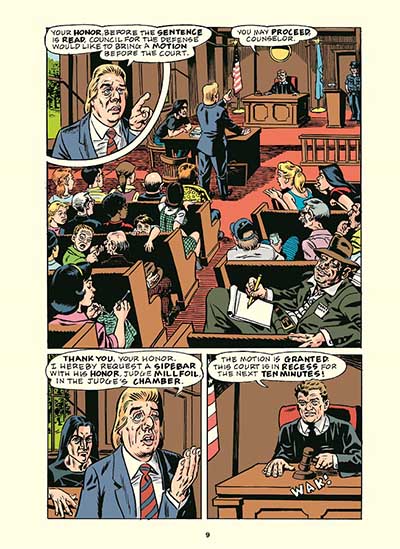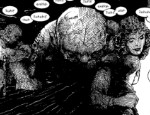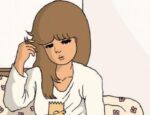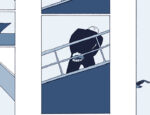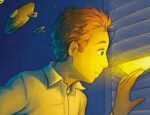If you were a fan of Peter Bagge’s Hate in the 1990s you may well remember the Doofus back-up strips by Rick Altergott that ran for some years in that most esteemed of alt comics publications. Depicting the adventures of the titular character, and his equally absurd sidekick Henry Hotchkiss, Doofus debuted in Eightball in 1992 and the characters’ world has made appearances in the pages of everything from Heavy Metal to Kramers Ergot.
Now Doofus and company are re-emerging in Altergott’s first long-form comics work Blessed Be from Fantagraphics where the slacker comedy and unrepentantly lowbrow humour associated with the strip is being given an extended space in which to breathe. After re-immersing myself in the lives of the cast via The Doofus Omnibus I chatted to Rick Altergott about the denizens of Flowertown, the changing face of alternative comics over the last few decades, and the art of the well-placed visual gag…
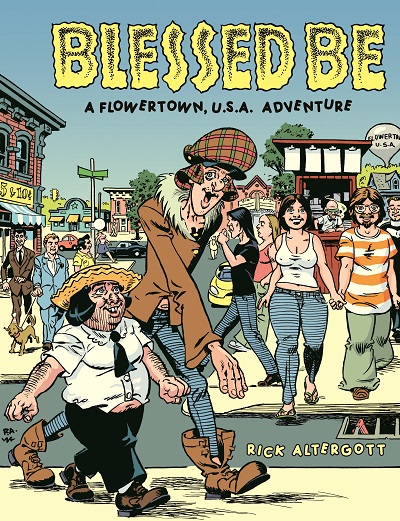
ANDY OLIVER: You’ve been chronicling the misadventures of the residents of Flowertown on and off in shorter strips for a few decades so the obvious question to begin with is how long have you been working on the full-length narrative of Blessed Be?
RICK ALTERGOTT: The idea for a longer narrative featuring Doofus and Henry Hotchkiss had been percolating alongside the appearance of many of the one-off gag strips for many years. One of the crazy things about Blessed Be is that it took so long to complete. In the back material for the book, I go into this a bit; how the nut of the story evolved in time. Originally, the story was serialized in the comic book that my wife, Ariel Bordeaux did together: Raisin Pie. She was doing a longer episodic story too, which appeared in “chapters” in that series. But, as she finished hers in the 5 issues of Raisin Pie, I didn’t, and left my readers hanging for over another full decade!
Quite a bit of the story was re-drawn and re-written from that stuff; color was added, and once freed from the episodic “cliffhanger” format, I greatly expanded things, for the better; I feel now. But one thing I know is, that this is not the way to do a long sustained narrative– over a long time, with moves, our child; so many interruptions and changes in life and perspective. It’s a different story than it would have been if I had executed it from a full script; and a better one, but unrealistic to produce this way. It still does follow the basic story trajectory, when all’s said and done.
AO: Given the often gag-based structure of the shorter strips how did you want to approach establishing an expanded story structure for Blessed Be in terms of premise and subplots?
ALTERGOTT: I tried to fold in as many short gags as I could, and integrate them into the story when I could. There was a period of time when I was actually producing weekly gag strips concurrently with making the graphic novel. That is one reason why it took so long to finish. I was creating new material for Vice online, using a mix of reprinted strips and new stuff. In fact, I was trying to serialize another Flowertown story in Vice, but the editors asked me to do standalone strips after a while. The other narrative I was doing was about the “Forty Acres Club” and Flowertown femme fatale, “Miss Juniper” –she of the “stinkies”; and how the secret society was responsible for world-changing events. I hope to complete that one some day. Maybe if Blessed Be is a success, I’ll be motivated to finish it.
In the 3 separate periods of my comics making career that I have produced weekly strips, I have found that being “in the game” heightens the receptors for coming up with ideas in a way that you don’t get otherwise. Maybe it’s desperation too, or settling for sub par material as the deadline approaches. Regardless, I think I came up with some of my best gag ideas when I was in that headspace. I certainly respect those who do it all the time!
AO: You’ve been living with these characters for 30-odd years so what is it about Doofus, Henry Hotchkiss, et al and what they represent that so appeals to you as a writer and artist? What specific parts of your psyche do they allow you to channel through them onto the page?
ALTERGOTT: These characters are kind of archetypical, a duo; kind of like the Honeymooners, an aggressive, bossy dominant guy and his even dumber sidekick. I’m not sure why I was drawn to them and was able to come up with storylines using them. Initially, I would shoehorn any gag I came up with to fit their circumstances. Even so, there are rules; such as Doofus’ mother is never shown, just heard, like the adults in Peanuts. For a longer work, such as the graphic novel, I was limited by them, as readers don’t really want much emoting or depth from either one, but I hope I was able to make it work. I wish the whole narrative didn’t have them separate from each other. I hope readers won’t be disappointed by that. I even threw in an epilogue showing the default situation to show things back to normal. As for my psyche; I can’t really say much, except that I only seem able to come up with sleazy, low brow stuff, no matter how I try!
AO: Revisiting some of the Doofus back catalogue in preparation for looking at Blessed Be, especially via The Doofus Omnibus, I was particularly struck by the sheer gross-out slapstick of some of the (admittedly very funny) humour in there. Have you ever managed to shock even yourself at any point over the years with that transgressive kind of comedy?
ALTERGOTT: Jokes seem to emanate like electricity, unbidden and without warning. Usually while doing something else, in my case. In my early days, I did come up with some pretty crude stuff, and it got the laughs, so I was encouraged to keep going with it. Henry Hotchkiss’ absent dad, the “lonely Inventor” resulted in a pretty rude punchline; one I probably wouldn’t go with today. The one with Henry Hotchkiss crabbing at the pier was pretty sleazy too, but I’m proud of it, nonetheless. I remember coming up with that joke while working at a weird place that silkscreened names and images on clear acrylic for trophies to give employees and lodge members.
AO: Flowertown is almost a character in itself in these pages – one that seems to pull together eras and period subcultures in a kind of time-spanning patchwork. What has Flowertown as an environment come to symbolise to you over the years?
ALTERGOTT: I have always felt gratified when people commented about Flowertown as a fictional location that somehow “spoke” to them in a way, if that’s the right word. I guess over the years, I fleshed it out to that degree. I go over this a bit in the back of the book, and I am genuinely thankful to all the people who have mentioned this as an aspect of my cartooning. In the book, I tried to keep the “world-building” going, and I finally created a map for the endpapers that identifies a lot of landmarks that appear in the story and throughout the years, too. When I was laying the spread out, it was uncanny how it all fit together, graphically.
AO: Your pages always reward re-reading for the background details that may have been missed the first time round and Blessed Be is no different. With that in mind can you give us some insights into your artistic process, the mediums you work in, and your inspirations?
ALTERGOTT: For some reason, I always throw in a lot of background details; the “Easter Eggs” that reward a second reading. Sometimes, it’s just that I never learned the cartoonist trick of lowering the camera angle, so I have to draw everything; all the way back to the vanishing point. More worm’s eye views! Because of this, I’ve probably drawn more sidewalks than any other cartoonist, and it kind of drives me crazy. But I’m also trying to realize my vision of something in my mind’s eye when I first conceive a scene. I also have binders of old photos that I took with certain buildings I like, and I really enjoy drawing them, always trying to distill their essence in a picture, and never really capturing it just right.
AO: As a cartoonist who has been part of the indie comics scene for a significant period of time what for you have been some of the most notable developments in the way both the community and the industry have evolved over the years?
ALTERGOTT: Yes, I’ve been drawing comics for a long time, and things have changed a lot. Things started out in black and white, and adding zip a tone was one way to give your page a little pizzaz. I’m glad I forced myself to learn how to hand letter my pages; that probably wouldn’t be a priority for a lot of younger cartoonists today. But I agree with Alex Toth, on this; it is an essential part of the page design and process. Good advice from a Master of the profession. I also learned to use a brush and dip pens too. All the tools are part of the process, and I wouldn’t want to work any other way, even as I lose some dexterity with age. All the little tricks you figure out along the way, ink flows best in hot Summer weather (or sweatshops), trying out different nibs and papers; sooner or later each artist finds what works best for him or her. It’s all part of what makes creating enjoyable and rewarding.
As for content, that certainly has changed. Part of my personal goal has always been to “Keep the Underground Alive” whatever that means. In my case it self-servingly means doing the sleazy low brow humor I’m mostly known for, and keeping that rebel vibe going (right). All of the greats in the original underground movement developed far beyond the lowest common denominator, sex and drugs; in your face stuff, of course. But for me, that is kind of my perch; I don’t know if I’ll ever transcend to more meaningful content; I feel sometimes deeper motifs filter in regardless and I’m glad when it does; I’m not entirely in control. I’m in awe of my contemporaries who have created such compelling, personal work, addressing the complexities of our times; these are the true artists who have moved the comics medium into its current legitimacy as a literary artform.
That said, I don’t want the silly, sleazy, stuff to get crowded out or outright cancelled, and I see a potential for that happening as tastes change and more “serious” and “important” work takes prominence, sometime led by crusaders types educating us about some terrible injustice that we need to know about and feel bad about. That stuff is usually devoid of any humor and as a result it is taken seriously outside of the comics world and often transcends it. I hope that comics never becomes “Oprah’s Book Club”; and that my stuff has a home. as flayed and fucked up as it sometimes is. Just last week we lost a truly authentic creator, Ed Piskor, who was following his own vision and even though I can’t relate to how dark some of his stuff was, I hate to think that a pressure campaign against him compelled him to take his own life.
Years ago, he sent me some of his self-published comics asking for my opinion of his work. He wrote and drew his own stuff, hand lettered, he would draw every brick on a wall. His energy and conviction was evident and unmistakable. Lots of latent talent and ambition. Now,a promising career is cut short, and a true comics evangelist is gone, regardless of how messed up some of his actions might have been. It isn’t a healthy place for the comics community to be no matter what side you’re on. I hope the future for the medium can embrace many different voices. Today, so many older comics are back in print for new eyes to examine, and the kind of storytellers are more diverse than ever. The potential is there.

AO: And, finally, are there any other projects you’re working on right now – whether they be in comics or other areas of the arts – that we should be looking out for?
ALTERGOTT: Right now, I’m inspired by the old Mystery anthology comics that I’ve been collecting for all my life (I’m old too!). I’m working on a comic book that has 4 different “mystery” stories like you might see in an old House of Secrets comic, with standard boilerplate plotlines, but skewed, so that the surprise endings are kind of deflated. We’ll see what happens with this one. I also have begun painting and printmaking. I show my work at a small unjuried gallery in Warren Rhode Island called The Collaborative.
Buy Blessed Be by Rick Altergott online here
Interview by Andy Oliver








